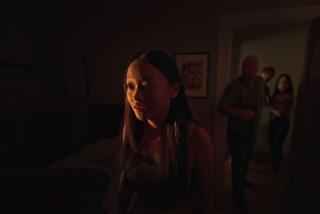A creepy feeling from ‘Bug’
- Share via
One of those shifty words that happens to describe a range of unrelated yet somehow mysteriously connected ideas, “bug” -- which can of course refer to a variety of insects as well as function as a synonym for things such as “to bother,” “to put under surveillance” and “to totally freak out” -- seems to span the range of delusional paranoid concerns like somebody planned it.
William Friedkin’s “Bug” is an adaptation of Tracy Letts’ play about a pair of lonely losers who hole up in an Oklahoma motel room together to crack up and fall apart. The play had successful runs in Chicago, New York and London, and coincidentally (or maybe not) is also running at the Coast Playhouse in West Hollywood through July 8. The film version, starring Ashley Judd and Michael Shannon (he also appeared in the original productions), is creepy and unsettling, to say nothing of gory, but overall it’s a little claustrophobic and uneven.
For the record:
12:00 a.m. May 25, 2007 For The Record
Los Angeles Times Friday May 25, 2007 Home Edition Main News Part A Page 2 National Desk 1 inches; 47 words Type of Material: Correction
‘Bug’: In some copies of today’s Calendar section, the review of the movie “Bug” gave June 3 as the date for the closing of the play that the film is based on. The production at the Coast Playhouse in West Hollywood has been extended to July 8.
The movie opens with an aerial shot of the motel, a middle-of-nowhere dump we’ve come to recognize as the kind of place where no good can come to anyone. And I’m not talking about bad cable reception or a broken ice machine. Something about the washed-out, yellowy beige landscape and the nervously undulating light suggests imminent bloodshed, and on this front “Bug” delivers, if in relatively small doses.
It takes some time to settle into the notion that Agnes, or Aggie (Judd), actually lives in the place, so unsettled is her demeanor and so impersonal her personal space. Aggie’s nervousness, we learn, is due to the recent release of her felonious ex-husband, Jerry (Harry Connick Jr.), who may be the person taunting her with all the silent phone calls she’s been receiving. As for her interior design sense, though, it’s suggested she’s lived here for a while and she has apparently never unpacked more than a bottle of booze and a cigarette.
It only takes looking at Aggie to know that she’s in for it, and the impression is confirmed when her best friend, R.C. (Lynn Collins), who is a lesbian, comes over with a guy for Aggie and some drugs for the three of them one night.
Shifty and quiet, tense and vulnerable, Peter looks and acts like the kind of guy horror movies were built on. Among the first things he says to our heroine is: “I’m not an ax murderer.” Among the second: “I make people nervous anyway.”
He’s not kidding.
Peter, it turns out, has a complicated psychological past further complicated by the U.S. Army, from which he’s gone AWOL. Opening up to Aggie about his past and his fears, he sounds -- not that we’re trained experts -- like your basic delusional schizophrenic. Then again, it might just be impossible not to sound like a delusional schizophrenic when describing certain top-secret Army protocols. I wouldn’t know.
To complicate matters further, Peter isn’t exactly the type to just say no, either -- though the drugs that show up near the beginning of the film don’t make another appearance until near the end.
Not having seen the theatrical production, it’s not possible for me to say how much better this concept worked onstage, but my guess is that “Bug” may be fundamentally better suited to the other medium. The problem is not the single-room set or the nonspecific depressive naturalist look of the production, or even the occasionally abstracted, cadenced language -- though none of these choices really quite supports what turns out to be a metaphysical freak-out inspired by a play on words.
The main problem for me was the fallback naturalism of the style, which made what must read on stage as ambiguity read on film as inconsistency. Aggie’s point of view -- which, after all, as she hungrily adopts her new boyfriend’s madness in order to stave off any more loneliness, is our entry into a purely imagined world -- is kept at a distance. Close-ups of Peter’s mysterious bloodsucking aphids -- whether they exist or no -- are notably missing. It’s one thing to take Aggie’s word for it that she does, in fact, see the bugs Peter so fervently believes in while she’s yards away on a stage; it’s another to do so when the camera could so easily give her eyeball-an-inch-away-from-his-finger- eye-view but chooses not to.
It comes as a surprise, as the movie advances, to realize that what we’re watching, gruesome as it becomes, is also a parody, and a very funny one at that. The shift in tone -- reflected in the ever more panicky language, the anti-insect redecoration of the room and the gruesomeness of the violence -- takes us from what begins as a grim, familiar drama into something much weirder. By the end, you wonder if you’re not hallucinating too.
There’s a clever and interesting conceit somewhere in here, and the creepiness of it gets under your skin. But “Bug’s” relentless unpleasantness, which Friedkin bogs us down in instead of crystallizing it into what might have been a stylish head trip, can get to be a chore.
“Bug.” MPAA rating: R for some strong violence, sexuality, nudity, language and drug use. Running time: 1 hour, 42 minutes. In general release.
More to Read
Only good movies
Get the Indie Focus newsletter, Mark Olsen's weekly guide to the world of cinema.
You may occasionally receive promotional content from the Los Angeles Times.








